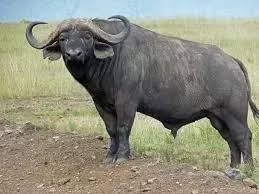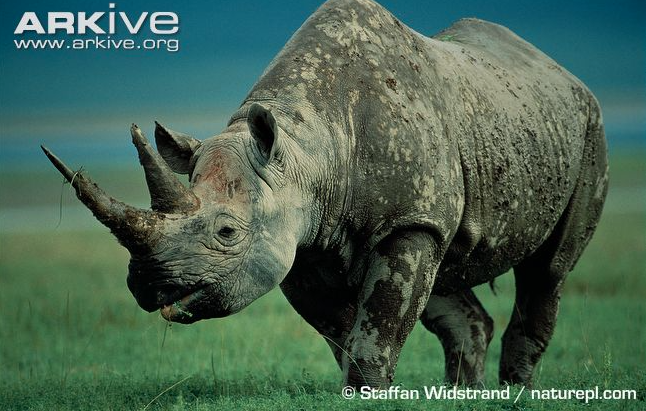Post by dinosauria101 on Sept 18, 2019 16:46:26 GMT 5
African (Cape) Buffaloes (2) - Syncerus caffer
The African buffalo, affalo, nyati, Mbogo or Cape buffalo (Syncerus caffer) is a large African bovine. It is not closely related to the slightly larger wild Asian water buffalo, but its ancestry remains unclear. Owing to its unpredictable nature which makes it highly dangerous to humans, it has not been domesticated, unlike its Asian counterpart, the domestic Asian water buffalo. The Cape buffalo is a very robust species. Its shoulder height can range from 1 to 1.7 m (3.3 to 5.6 ft) and its head-and-body length can range from 1.7 to 3.4 m (5.6 to 11 ft). The tail can range from 70 to 110 cm (28 to 43 in) long. Savannah type buffaloes weigh 500 to 910 kg (1,100 to 2,000 lb), with males, normally larger than females, averaging 768 kg (1703 lbs). A record-sized savannah-type male weighed 1,000 kg (2,200 lb). Forest type buffaloes, at 250 to 455 kg (550 to 1,000 lb), are only half that size. Its head is carried low, its top located below the backline. The front hooves of the buffalo are wider than the rear, which is associated with the need to support the weight of the front part of the body, which is more powerful than the back.

Black Rhinoceros - Diceros bicornis
An adult Black Rhinoceros stands 140–170 cm (57.9–63 inches) high at the shoulder and is 3.3-3.6 m (10.8–11.8 feet) in length. An adult weighs from 800 to 1364 kg (1,760 to 3,000 lb), but sometimes grows up to 1818 kg (4,000 lb), The females are smaller than the males. Two horns on the skull are made of keratin with the larger front horn typically 50 cm long, exceptionally up to 140 cm. The longest known horn measured nearly 5 feet in length. Sometimes, a third smaller horn may develop. These horns are used for defense, intimidation, and digging up roots and breaking branches during feeding. Skin color depends more on local soil conditions and the rhinoceros' wallowing behavior than anything else, so many black rhinos are typically not truly black in color. The Black Rhino is much smaller than the White Rhino, and has a long, pointed, and prehensile upper lip, which it uses to grasp leaves and twigs when feeding. White Rhinoceros have square lips used for eating grass. The Black Rhinoceros can also be recognized from the White Rhinoceros by its smaller skull and ears. Black Rhinoceros also do not have a distinguishing shoulder hump like the White Rhinoceros.

Credit to Wikipedia
The African buffalo, affalo, nyati, Mbogo or Cape buffalo (Syncerus caffer) is a large African bovine. It is not closely related to the slightly larger wild Asian water buffalo, but its ancestry remains unclear. Owing to its unpredictable nature which makes it highly dangerous to humans, it has not been domesticated, unlike its Asian counterpart, the domestic Asian water buffalo. The Cape buffalo is a very robust species. Its shoulder height can range from 1 to 1.7 m (3.3 to 5.6 ft) and its head-and-body length can range from 1.7 to 3.4 m (5.6 to 11 ft). The tail can range from 70 to 110 cm (28 to 43 in) long. Savannah type buffaloes weigh 500 to 910 kg (1,100 to 2,000 lb), with males, normally larger than females, averaging 768 kg (1703 lbs). A record-sized savannah-type male weighed 1,000 kg (2,200 lb). Forest type buffaloes, at 250 to 455 kg (550 to 1,000 lb), are only half that size. Its head is carried low, its top located below the backline. The front hooves of the buffalo are wider than the rear, which is associated with the need to support the weight of the front part of the body, which is more powerful than the back.
Black Rhinoceros - Diceros bicornis
An adult Black Rhinoceros stands 140–170 cm (57.9–63 inches) high at the shoulder and is 3.3-3.6 m (10.8–11.8 feet) in length. An adult weighs from 800 to 1364 kg (1,760 to 3,000 lb), but sometimes grows up to 1818 kg (4,000 lb), The females are smaller than the males. Two horns on the skull are made of keratin with the larger front horn typically 50 cm long, exceptionally up to 140 cm. The longest known horn measured nearly 5 feet in length. Sometimes, a third smaller horn may develop. These horns are used for defense, intimidation, and digging up roots and breaking branches during feeding. Skin color depends more on local soil conditions and the rhinoceros' wallowing behavior than anything else, so many black rhinos are typically not truly black in color. The Black Rhino is much smaller than the White Rhino, and has a long, pointed, and prehensile upper lip, which it uses to grasp leaves and twigs when feeding. White Rhinoceros have square lips used for eating grass. The Black Rhinoceros can also be recognized from the White Rhinoceros by its smaller skull and ears. Black Rhinoceros also do not have a distinguishing shoulder hump like the White Rhinoceros.

Credit to Wikipedia



